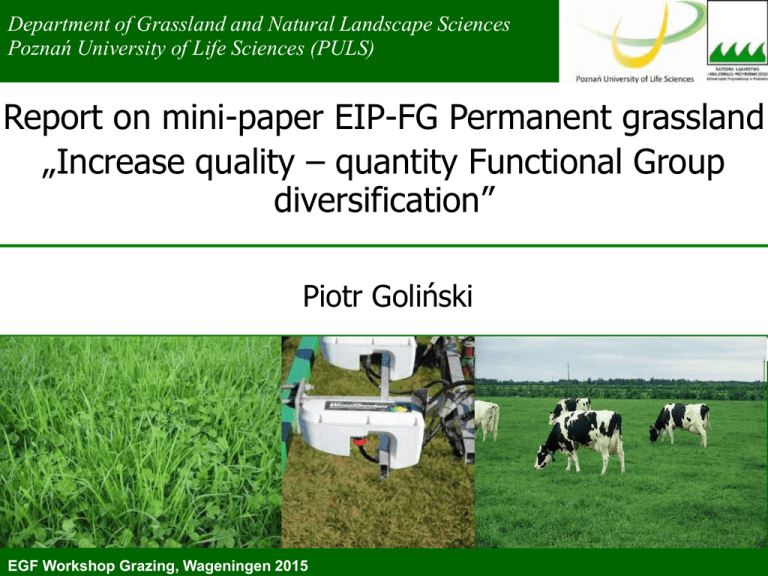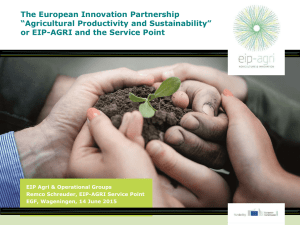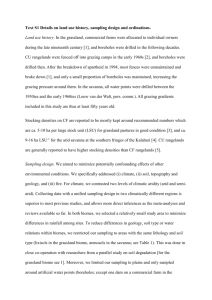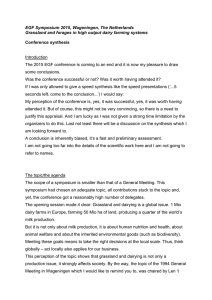Report on mini-paper EIP-FG Permanent grassland diversification”
advertisement

Department of Grassland and Natural Landscape Sciences Poznań University of Life Sciences (PULS) Report on mini-paper EIP-FG Permanent grassland „Increase quality – quantity Functional Group diversification” Piotr Goliński EGF Workshop Grazing, Wageningen 2015 EIP Focus Group Permanent Grassland Why increased functional group diversification within grassland is essential for ‘sustainable’ production? Piotr Goliński, John Bailey, David Gomes Crespo, Agnes van den Polvan Dasselaar, Vibeke Lind, María Rosa Mosquera-Losada, Michael O'Donovan, Alain Peeters, Claudio Porqueddu & Dirk Reheul Introduction • Increased functional group diversity of sward correlates with increased stability and productivity of grassland • Increasing functional diversity decreases the risk of invasion by undesired species • Benefits concerning functional group diversity on grassland can be obtained by appriopriate composition of grasses, legumes, some herbs and in silvopastoral vegetation - trees. • Multi-species swards resulted potential higher spatial heterogenity of biomass, sward quality and forage intake • Grass-legume mixtures enhance yield of total nitrogen and uptake from symbiotic N2 fixation EIP Focus Group Permanent Grassland Introduction • In productive grassland systems the positive diversity effect could be obtained from a mixture of just a few species, well adapted to the environmental conditions; mixed pasture sward with legumes instead of monoculture of ryegrass increases both productivity per unit of hectare and extend the grazing season • In pastoral farming systems of the Mediterranean basin the maintenance of a high level of inter and intra-specific diversity (e.g. BLRSPP) is essential to achieve satisfactory and persistent sward EIP Focus Group Permanent Grassland Research projects • COST Action 852 • LINK Project LK0638 • Forbioben • Multisward • Permed • Agforward EIP Focus Group Permanent Grassland Opportunities for uptake by farmers • Use of multi-species mixtures for grassland establishment and renovation • Use of high quality and/or phenologically different grass cultivars in seeds mixtures • Use of effective and ecologically friendly methods of sward renovation • Use of soil analysis to accurately determine the content of nutrients in the soil • Optimum use of organic and mineral fertilizers • Optimize the cutting or grazing time and regime in regard to forage quality improvement EIP Focus Group Permanent Grassland Potential innovative actions • Knowledge transfer to farmers about grassland management focusing on increased functional group diversification by using innovative information tools • Adopt a rational plan of soil fertilization/amendments according to soil nutrients content and dynamics to adequately supply nutrient to grasslands • Provide the farmers with information about potential forage quality by means of user-friendly, low-cost, ICT-based tools EIP Focus Group Permanent Grassland Research needs • Monitor forage status of grassland by remote sensing • Compose of seed mixtures for each soil/climate condition by using functional groups principle • Evaluate of entries of pasture plants for breeding and selection new genotypes • Enhance N fixation and phosphate availability for grasslands by improvement of soil/plant microbiology (inoculants) • Manage of legumes under grazing for its better persistence • Develop simple tools to fertilize and amend of pasture • Develop new solutions for mechanical weed control in grassland sward EIP Focus Group Permanent Grassland Grazing of dairy cows in Poland – good example • Large-area farm Juchowo in middle part of Pomerania • Biodynamic-organic system of feed production (multispecies sward with high share of legumes, no mineral fertlization) • Rotation pasture, irrigated and regularly renowated every 3-4 years • 360 dairy cows (HF „grazing type” and brown swiss) grazed the pasture sward from end of April to half of October and feeded by high quality hay in winter, addition a few concentrates from own sources) • Average milk yield ca. 6500 kg per cow EGF Workshop Grazing, Wageningen 2015 Multi-species pasture sward sown every 3-4 years Irrigation of the pasture according to water needs Grazing of the dairy cows on the pasture Supplementation of the grazed sward by hay The grazing of dairy cows in Poland has not perished yet






